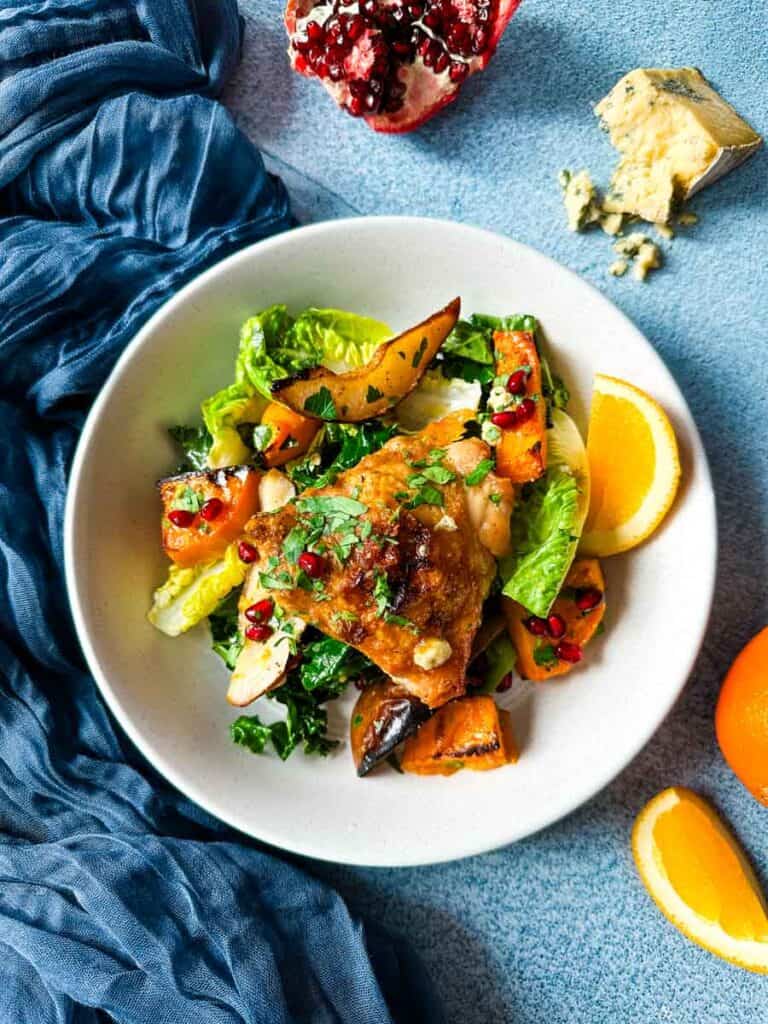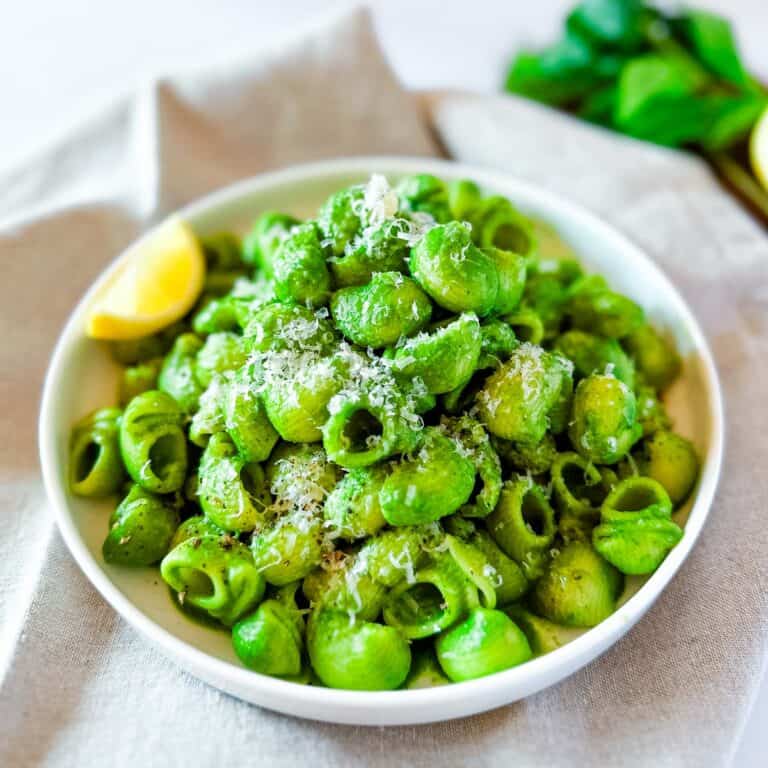The Best Homemade Pistachio Pesto with Basil and Mint
This homemade pistachio pesto with basil and mint is the ultimate way to add incredible flavor to your cooking! A handful of fresh ingredients come together in just 5 minutes, and are ready to be swirled into pasta, drizzled on pizza, schmeared on a sandwich, or tossed into a potato salad—you can’t go wrong!

💌 Save This Recipe
I'll also send you other recipes I know you'll love. Unsubscribe at any time.
I love a good sauce – we all know that. We also know that fresh basil season is the best season!
Enter pesto.
But this isn’t classic basil pesto.
Allow me to introduce you to my flavorful and dreamy pistachio pesto with basil and mint—a fun twist on traditional pesto recipes that you’ll want to put on just about everything.
This versatile sauce is perfect for drizzling over roasted veggies and pizza, tossing with pasta, spooning onto grilled meats and fish, or even spreading on sandwiches. And the best part? You can make large batches and freeze them to enjoy long after fresh basil season ends.
I’ll walk you through this simple pistachio pesto recipe step by step—it couldn’t be easier.
Let’s get into it!
Why I love this recipe:
Recipe Ingredients

Ingredient Notes & Substitutions
High quality ingredients are crucial to make this pesto, which are easy to find and readily available at any grocery store. If you’re able, I would highly recommend grabbing anything you can out of your own herb garden or at your local farmer’s market for the best fresh flavors.
Here are a few ingredient notes:
Let’s Make It Together: STEP BY STEP
Be sure to check out the full recipe details and ingredient list in the recipe card below.
Steps 1 & 2:
Add the pistachios and garlic to the food processor bowl. Pulse until the pistachios and garlic are chopped into small pieces (as shown in the picture below). Then, add the fresh basil leaves, fresh mint, lemon zest, salt, and pepper.



Steps 3, 4 & 5:
Pulse the herbs until they are chopped to a size just slightly larger than the pistachios. Next, with the food processor running, drizzle in the oil. When that is well combined, add the cheese and pulse only until it is stirred into the pesto.



Steps 6 & 7:
The texture should be medium-thick, but able to be spooned and drizzled. Add any additional olive oil or herbs to achieve the right texture. Transfer it to a bowl to use or transfer it to an airtight container for storage. Before placing the lid, place a piece of plastic wrap onto the top of the pesto to prevent oxidation.




Natalie’s Expert Tips
- Use the very best, high-quality ingredients for the absolute best flavor!
- Pesto should have texture – it should not be a smooth sauce, but it also shouldn’t have large pieces in it.
- For the best texture, don’t throw all of the ingredients into the food processor at once (just as you wouldn’t if you were using a mortar & pestle). Pulse the nuts and garlic together first so that they are chopped into small pieces before adding the herbs. Next, add the herbs and pulse those before drizzling the olive oil. And lastly, stir in the parmesan cheese.
- When using a mortar and pestle, follow these same steps.
- How you store pesto is important. To maintain its bright green color and flavor, it is important to keep air off of it to prevent oxidation. After much trial and error, I have found that the best way to do this is to put it in a jar or container, add a layer of plastic wrap on top, and touch the pesto before sealing with an airtight lid.

Serving Suggestions
There are so many ways to use pesto – it is only limited by your creativity!
- Stir it into cooked pasta with a little pasta cooking water (to loosen it up).
- Drizzle it on my weeknight eggplant parmesan or homemade pizza.
- Slather it onto a sandwich – a cold caprese or a grilled cheese.
- Add it to a salmon filet like I did in this slow roasted pesto crusted salmon.
- Add it to some brothy white beans for an excellent side dish.
- Add a dollop to a bowl of vegetable soup to add a touch of brightness.
- Serve it on the side of my lemon grilled chicken or this spatchcocked grilled chicken.
Storage
STORAGE:
To store this pesto in the refrigerator, place it into an airtight container (I tend to like glass jars best). Before you cover it with the lid, add a piece of plastic wrap to the top of the pesto, making sure that it touches the pesto, before sealing with a lid. This will eliminate extra air and oxidation, keeping its bright green color. You can also add a thin layer of olive oil to the top of the pesto before storing it, to keep an air out. The pesto will keep in the refrigerator for up a week.
FREEZING:
Pesto freezes well in an airtight container for up to 6 months. You can also freeze the pesto in ice cube trays and then once they are frozen, transfer the cubes to a ziploc freezer bag to store in the freezer. Thaw the pesto in the refrigerator overnight before using.

Frequently Asked Questions
More incredible sauces & vinaigrettes that you’ll love
I hope you love this HOMEMADE PISTACHIO PESTO!
If you make it, be sure to leave a rating so I know how you liked it!
The Recipe

The Best Homemade Pistachio Pesto with Basil and Mint
Ingredients
- 1/4 cup pistachios (raw or toasted, your choice)
- 2 cups basil (fresh leaves, packed)
- 1/2 cup mint (fresh leaves, packed)
- 1 lemon (zest only)
- 3/4 teaspoon kosher salt
- 1/4 teaspoon black pepper
- 1/2 cup extra virgin olive oil
- 1/2 cup parmesan cheese (preferably Parmigiano-Reggiano)
Instructions
- Add the pistachios and garlic clove to a food processor and pulse until chopped into small pieces. (If you are using a mortar and pestle, pound until you get a paste with small pieces.)
- Next, add the basil, mint, lemon zest, salt and pepper. Pulse in the food processor until chopped into small pieces (and pound in the mortar and pestle until all pieces are the same size and well combined).
- While the food processor is running, add the olive oil a little at a time until well combined. (In the mortar and pestle, drizzle in the olive oil a little at a time and stir around until well combined.)
- Lastly, add the parmesan cheese and pulse until just combined and then transfer to a small bowl or storage container. (In the mortar and pestle, stir in the cheese.)
💌 Save This Recipe
I'll also send you other recipes I know you'll love. Unsubscribe at any time.
Notes
- Pesto should have texture – it should not be a smooth sauce, but it also shouldn’t have large pieces in it.
- For the best texture, don’t throw all of the ingredients into the food processor at once (just as you wouldn’t if you were using a mortar & pestle). Pulse the nuts and garlic together first so that they are chopped into small pieces before adding the herbs. Next, add the herbs and pulse those before drizzling the olive oil. And lastly, stir in the parmesan cheese.
- When using a mortar and pestle, follow these same steps.
- How you store pesto is important. To maintain its bright green color and flavor, it is important to keep air off of it to prevent oxidation. After much trial and error, I have found that the best way to do this is to put it in a jar or container, add a layer of plastic wrap on top, and touch the pesto before sealing with an airtight lid.
Nutrition
Did you make this recipe? I want to know!
I’d love to hear from you! Consider leaving a comment and rating below.
My readers love to read your reviews, adaptations and suggestions! Have a question? I’ll personally respond within 24 hours. Please share any photos on instagram and tag me @nataliemarblecooks so I can see your creations!








